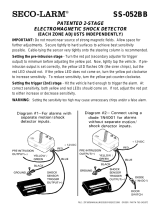
- 8 -
Programming for:
1WFM6R
1. Insert the key into the ignition and turn the ignition ON then OFF five times.
2. The fifth time you turn the ignition on, the parking lights will flash once.
3. Tap the Lock button on the transmitter once. The parking lights will again flash
once to confirm that the remote was coded.
4. After a few seconds, the parking lights will flash twice to signal the ending of
the remote programming mode.
If you have multiple remotes, you can program them all at once by coding the first
remote, then right after getting the confirmation flash, coding the second remote
(you will get another confirmation flash), and then coding the third remote.
Programming for:
2WFMR-S, 2WAMR, 2WFMR, and 2W900FMR
1. Insert the key into the ignition and turn the ignition ON then OFF five times.
2. The fifth time you turn the ignition on, the parking lights will flash once.
3. Tap the ( I ) button on the transmitter once. The parking lights will again flash
once to confirm that the remote was coded.
4. After a few seconds, the parking lights will flash twice to signal the ending of
the remote programming mode.
If you have multiple remotes, you can program them all at once by coding the first
remote, then right after getting the confirmation flash, coding the second remote
(you will get another confirmation flash), and then coding the third remote.
Programming for:
2WSSR
1. Pull the positive side of the battery out of the 2WSSR, do not remove the whole
battery as you will need to quickly insert it again.
2. Insert the key into the ignition and turn the ignition ON then OFF five times.
3. The fifth time you turn the ignition on, the parking lights will flash once.
4. Quickly push the positive side of the battery back into the 2WSSR. The parking
lights will flash once to confirm that the remote was coded.
5. After a few seconds, the parking lights will flash twice to signal the ending of
the remote programming mode. Do not press any buttons on the remote, the
2WSSR will still be in the process of synchronizing. As soon as the 2WSSR
chirps once or twice, you are finished and can use the remote. This should only
take a few seconds.























